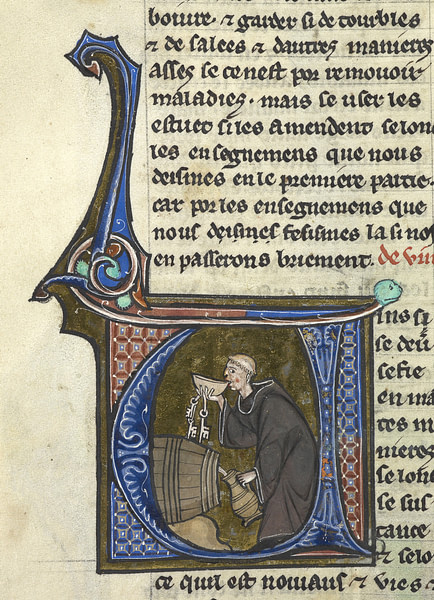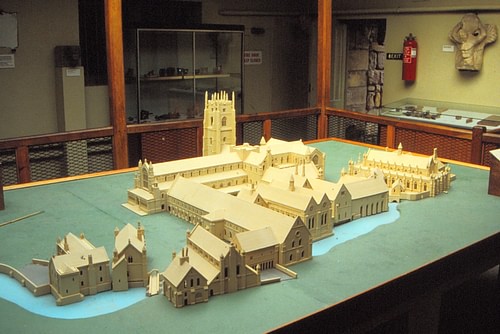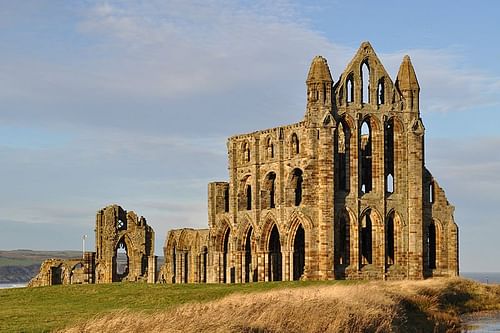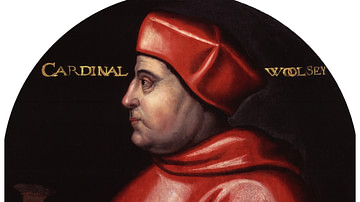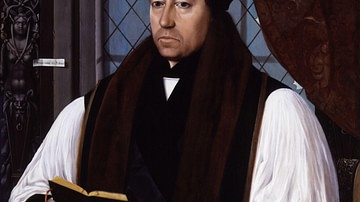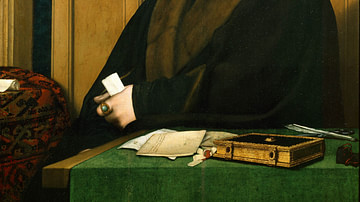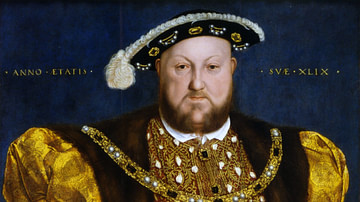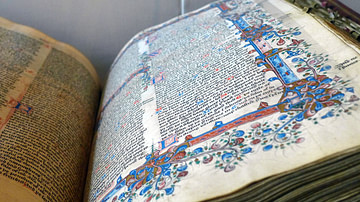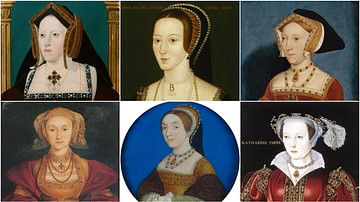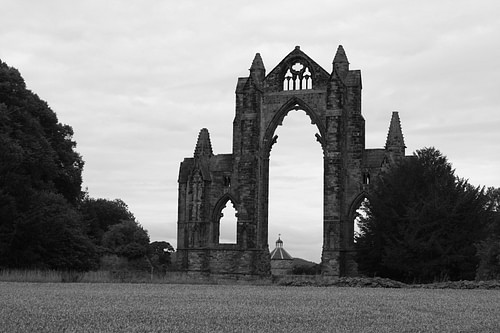
The Dissolution of the Monasteries was a policy introduced in 1536 CE by Henry VIII of England (r. 1509-1547 CE) to close down and confiscate the lands and wealth of all monasteries in England and Wales. The plan was designed as a lucrative element of his Reformation of the Church.
The closures of these Catholic institutions, even if they were no longer in their prime, did not go without opposition or consequences, notably seen in the Pilgrimage of Grace rebellion of 1536 CE, but by 1540 CE all monasteries had been closed, several important abbots were hanged and their lands confiscated for the Crown. Consequently, only stone ruins would remain as testimony to the now lost wealth and once-great standing of the monasteries in medieval society.
Henry VIII & the Reformation
Henry began his Reformation of the Church in England and break from Catholic Rome largely because he wanted to divorce his first wife Catherine of Aragon and marry Anne Boleyn (c. 1501-1536 CE). The king wanted a male heir, and Catherine was now deemed unsuitable for the task. The Pope would not annul Henry's first marriage, and so a series of events orchestrated by Henry's chancellor Thomas Cromwell (l. c. 1485-1540 CE) led to the king declaring himself head of his own church so that he could, in effect, grant himself his own divorce. Thomas Cranmer, the Archbishop of Canterbury formally annulled Henry's first marriage in May 1533 CE, and Henry's daughter with Catherine, princess Mary (b. Feb. 1516 CE), was declared illegitimate and so disinherited. Henry was excommunicated by the Pope for his momentous actions, but this was only the beginning. The king now seemed to consider himself chosen by God to push through further religious reforms in England and so pursue the Reformation that had been sweeping across Europe.
The Act of Supremacy of 28 November 1534 CE formally made the English king head of the Church of England. Henry VIII now had no higher authority than God himself. In 1536 CE the king made his first practical move in the long game of politics and religion that became the English Reformation: he presented Parliament with a bill to abolish all monasteries in his kingdom, the Dissolution of the Monasteries. The bill was passed, the first step of what would turn out to be a rocky and far from straightforward road to making England a Protestant state. Perhaps more than religious considerations, though, Henry was really motivated in acquiring a cash injection after the state coffers had been alarmingly inadequate ever since the war with France of 1522-3 CE.
The Role of the Monasteries
Monasteries had been an integral part of local communities for centuries. They were places held in awe by many as the home of those who dedicated their lives to Christ and saying prayers for the souls of both the living and dead. The monasteries gave out alms and other charity work for the benefit of the poor, those without work, and widows; they educated young poorer children and the older children of the wealthy; dispensed medicine; provided employment to labourers to work their estates; were valuable customers for village craftsmen; offered hospitality to pilgrims, travellers, and seasonal labourers; and they gave spiritual guidance. Monasteries were both repositories and producers of artworks and books, the protectors of shrines, sacred relics, and the guardians of miracle-working objects.
In the 1530s CE, there were still some 800 monasteries spread across England and Wales, but many were in decline. Indeed, Henry's then chancellor, Cardinal Wolsey (l. c. 1473-1530 CE) had already shut down 29 monastic houses during the early 1530s CE. There were far fewer monks, friars, and nuns across the country than there had been in the Middle Ages and many monasteries, nunneries, and priories struggled to find enough staff to look after them properly. The monastic estates remained impressive, though, and entailed some 20% of all the cultivated land in Henry's kingdom. This was a tempting target indeed.
The Wealth of the Monasteries
The first stage of what was obviously a carefully prepared and premeditated strategy was to assess exactly what wealth was available where. Accordingly, Cromwell organised a team of laymen assessors to travel the realm and note the financial situation regarding every single monastic institution in England and Wales. The findings would be listed in the comprehensive catalogue of riches known as the Valor Ecclesiasticus of 1535 CE. In addition to these purely fiscal reports, another group of Cromwell's men - mostly pro-Reformist clergy - also compiled a list of transgressions and abuses involving members of monastic institutions. This list of offences, which could be anything from petty corruption to disregarding the Oath of Supremacy, became the Comperta Monastica (aka Compendium Compertorum), and it would be a handy tool in the repression of the monasteries yet to come. The conclusion of Cromwell's endeavours was that the Church had an annual income of up to 360,000 pounds (over 150 million pounds today).
Henry, Cromwell, and those in favour of closing the monasteries were typically sceptical of their positive contribution to the community, the relevance of those who lived monastic lives, and certainly of the religious value of such things as relics and objects believed capable of miracles which attracted so many pilgrims to see them. Now, the financial and moral assessments carried out by Cromwell were made to show that despite a vast income, the Church, and especially the monasteries, were giving back to their communities only a very tiny fraction of this wealth (typically only 5% of a monastery's income went to the poor). Even more damning were the confessions Cromwell had extracted from monks and nuns that they had not been respecting their vows of chastity. Henry VIII could thus present himself the leader of the Church who was putting his house in order for the spiritual and financial good of all.
Closing Smaller Monasteries
Cromwell's assessors travelling about the kingdom did not go unnoticed and rumours began to fly around of what exactly they were up to. Some crowds even gathered to prevent the inspectors from doing their work. Confirmation came in the form of the 1536 CE Act for the Dissolution of the Smaller Monasteries. The justification for the closures of priories and smaller monasteries and nunneries was in the preamble of the act: the low morals of many monks and nuns and their corrupt use of the monastery's resources. The main body of the act then described the poor financial state of these institutions and their obvious decline. The practical cut-off point was that any institution which had less than 200 pounds annual income would be closed. The result was 399 closures while another 67 which might have been closed had to pay a heavy fine to maintain their existence. To smooth the whole operation, senior monks, priors, and abbots were given generous pensions. With their leaders gone, all those who still resided in the closed-down institutions had to either move to another larger one or give up their calling.
Support
Henry's policy met with approval by many, and not just zealous Protestants. Many nobles were equally content to grab their own bit of Church lands and riches, the king using monastic estates to favour his supporters and gain new ones. Additionally, many commoners were quite happy, too, to see the back of those rapacious and corrupt priests and monks who had blighted their villages. It is also true that many of Henry's subjects seemed entirely indifferent to the Reformation as a whole and cared not how they worshipped God. The majority seemed to have been content enough to follow the directions of the religious and political authorities. Nevertheless, there was a significant proportion of the population who were aghast at the closing down of such familiar community institutions as monasteries, bastions of the medieval church.
Opposition & Rebellion
The most dramatic response to Henry's closure of monasteries was the series of rebellions known as the Pilgrimage of Grace. In October 1536 CE nobles, minor gentry, monks, clergy, and commoners all combined to show their protest at the closures. Beginning in Lincolnshire and then breaking out again in York and elsewhere in the north of England, some 40,000 protestors marched, taking control of York and Pontefract Castle. The rebellion presented the Tudor Period (1485-1603 CE) with its greatest domestic threat. The protesters had multiple grievances, although the majority were related to religious matters. There was a general feeling that the interests of the north of England were not well represented in Henry's government which was felt to be corrupted by low-class ministers not fit for office, that southern nobles were merely plundering the riches of the monasteries for their own personal gains, and that a whole raft of new taxes was on the way. There had been two poor harvests in a row, prices were rising, and land enclosures were taking away hunting and fishing opportunities from commoners.
Not coincidentally, there was a large number of monasteries in both Lincolnshire and Yorkshire, and one of the first moves of the protestors had been to open back up some of the smaller closed monasteries. Finally, there was the perception that once the monasteries had gone, what would Henry's next target be?
The Pilgrimage of Grace, led by such figures as the York lawyer Robert Aske (c. 1500-1537 CE) and the nobleman Lord Darcy (1467-1537 CE), was an organised and population-wide movement involving all social levels. The protestors asked for a return to friendly relations with the Papacy, to restore Princess Mary as a legitimate heir, and to dismiss the architects of the Reformation like Archbishop Cranmer. This was a dangerous serpent indeed for a monarch to have in his backyard and Henry was determined to cut off its head before it grew into more monstrous proportions. The king sent an army of 8,000 men led by the Duke of Norfolk to persuade the protestors to disband. As it turned out, this was remarkably easy to do as the protestors were promised reforms and full pardons. By 10 December the 'pilgrims' had evaporated. Henry might have left it at that but for a third outbreak of rebellion, unrelated to the first two but also in Yorkshire, in January 1537 CE. The king then took the opportunity to round up the leaders of the Pilgrimage of Grace and execute nearly 200 of them, including Aske and Darcy. Amongst the victims were the abbots of Whalley, Kirkstead, and Jervaux, and the ex-abbot of Fountain's Abbey.
Closing Larger Monasteries
Henry, even if perhaps now more cautious, was still determined to press on with his religious reforms come what may and to continue with his Dissolution of the Monasteries. He sought out those whom he felt most strongly opposed his policies such as the abbot and monks of Sawley who were rounded up and hanged. Next came the 1539 CE Act of Parliament which brought about the closure of all remaining monasteries regardless of size or income. Most institutions acquiesced - there was nothing they could do legally and abbots had to obey the Head of the Church; many had already prepared by distributing their precious objects to safe places. Those who resisted were executed. The abbots of Glastonbury, Colchester, Reading, and Woburn all resisted and all were hanged. The last monastery to close was Waltham Abbey in Essex in March 1540 CE.
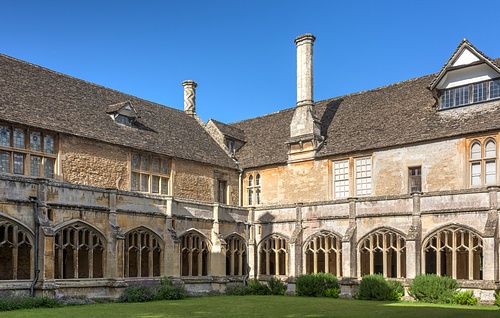
Consequences of the Dissolution
Henry VIII did indeed increase the state coffers as a whopping 1.3 million pounds (over 500 million today) was gained from the Dissolution of the Monasteries, although much of the land was sold off cheaply to nobles and the cash was largely wasted on foreign wars or spent on Henry's many royal building projects. Around 7,000 monks, friars, nuns, and other residents of the monasteries were obliged to find alternative work and homes while the blow on morale within the Church was immeasurable - although tangible in the great reduction in those now seeking an ecclesiastical career. Without the abbots present, the House of Lords was dominated by laymen. Treasures were melted down, roofing stripped of lead, and libraries sacked. The old medieval world lost many of its surviving art and artefacts, much to posterity's sorrow.
Without doubt communities must have missed the charity work, employment, and spiritual aid of their local monastery. Some historians have suggested that the lack of alms for the impoverished led to a leap in vagrants which in turn led to greater crime and social instability. While the larger buildings might have fallen into ruin such as Glastonbury, Fountains Abbey and Whitby Abbey, some wealthy landowners would have at least benefitted from their masonry to build mansions of one sort or another. Several of the larger monastery churches were converted into cathedrals, examples being Bristol, Chester, Gloucester, and Westminster. Smaller churches such as at Bath and Tewkesbury were sometimes bought by their community collectively to take on the role of the parish church. In this way, the legacy of the monasteries survived as many were literally absorbed into the urban spread of ever-growing towns and cities.
